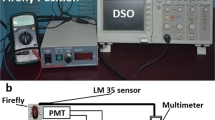Summary
Males of the fireflyPteroptyx cribellata of Papua New Guinea luminesce spontaneously in two principal modes: a regular one-per-second display flash (Fig. 1 A) and an irregular flicker of 3–10 peaks per second (Fig. 1B). In free run rhythmic display flashing by intact, restrained individuals, serial correlation analysis of interflash duration in successive cycles indicates that the variability of the brain-to-lantern excitation delay is negligible in comparison with the variability of the endogenous timing process (Figs. 6, 7). It is therefore possible to use the duration of the flash-to-flash interval of the intact firefly as a measure of endogenous pacemaker timing behavior. It is deduced that the cycling of the pacemaker is continuous, does not require that the animal see his own flash or even that he flash (Fig. 2 A), shows intercycle independence (Fig. 5) and may phase-shift its rhythm spontaneously upon occasion (Fig. 2C). Pacemaker period is normally distributed (Fig. 3), is not correlated with flash intensity, and appears to shorten slightly if a flash is skipped (Table 3). The occurrence of spontaneous flash skipping is taken to indicate that the timing process that measures pacemaker period can cycle independently of its usual triggering of the flash-excitation message to the lantern.
Similar content being viewed by others
References
Bagnoli P, Brunelli M, Magni F, Musameci D (1976) Neural mechanisms underlying spontaneous flashing and its modulation in the fireflyLuciola lusitanica. J Comp Physiol 108:133–156
Ballantyne LA, McLean MR (1970) Revisional studies on the firefly genusPteroptyx Olivier (Coleoptera: Lampyridae; Luciolinae; Luciolini). Trans Am Entomol Soc 96:223–305
Brunelli M, Magni F, Pellegrino M (1977) Excitatory and inhibitory events elicited by brief photic stimuli on flashing of the fireflyLuciola lusitanica (Charp.). J Comp Physiol 119:15–35
Buck J (1966) Unit activity in the firefly lantern. In: Johnson FH and Haneda Y (eds) Bioluminescence in progress. Princeton University Press, Princeton, pp 459–474
Buck J, Buck E (1966) Biology of synchronous flashing of fireflies. Nature 211:562–564
Buck J, Buck E (1968) Mechanism of rhythmic synchronous flashing of fireflies. Science 159:1319–1327
Buck J, Buck E (1978) Toward a functional interpretation of synchronous flashing by fireflies. Am Nat 112:471–492
Buck J, Case JF (1961) Control of flashing in fireflies. I. The lantern as a neuroeffector organ. Biol Bull 121:234–256
Buck J, Case JF, Hanson FE (1963) Control of flashing in fireflies. III. Peripheral excitation. Biol Bull 125:251–269
Buonamici M, Magni F (1967) Nervous control of flashing in the fireflyLuciola italica L. Arch Ital Biol 105:323–338
Carlson AD (1969) Neural control of firefly luminescence. In: Beament JWE, Treherne JE, Wigglesworth VB (eds) Adv Insect Physiol, vol 6. Academic Press. London New York, pp 51–96
Case JF, Buck J (1963) Control of flashing in fireflies. II. Role of central nervous system. Biol Bull 125:234–250
Case JF, Trinkle MS (1968) Light-inhibition of flashing in the fireflyPhoturis missouriensis. Biol Bull 135:476–485
Hagiwara S (1949) On the fluctuation of the interval of the rhythmic excitation. I. The efferent impulse of the human motor unit during voluntary contraction. (Transl) Rep Physiol Sci Inst Tokyo Univ 3:19–25
Hagiwara S (1950) On the fluctuation of the interval of the rhythmic excitation II. The afferent impulse from the tension receptor of the skeletal muscle. Rep Physiol Sci Inst Tokyo Univ 4:28–35
Hanson FE, Miller J, Reynolds GT (1969) Subunit coordination in the firefly light organ. Biol Bull 137:447–464
Hanson FE, Case JF, Buck E, Buck J (1971) Synchrony and flash entrainment in a New Guinea firefly. Science 174:161–164
Hoy RR, Hahn J, Paul RC (1977) Hybrid cricket auditory behavior: Evidence for genetic coupling in animal communication. Science 195:82–84
Lloyd JE (1973) Fireflies of Melanesia: Bioluminescence, mating behavior, and synchronous flashing (Coleoptera: Lampyridae). Environ Entomol 2:991–1008
Magni F (1967) Central and peripheral mechanisms in the modulation of flashing in the fireflyLuciola italica L. Arch Ital Biol 105:339–360
Mets LJ (1975) A general method for distinguishing the fundamental timer for a biological rhythm from cyclic processes which it times. Biophys J 15:177A
Author information
Authors and Affiliations
Additional information
We are much indebted to Drs. D. Alkon, T.H. Bullock, A. Carlson, F. Dodge. J. Enright, H. Gainer. R. Josephson, H.M. Pinsker, C.L. Prosser. A. Winfree and the late K. Roeder for various information, suggestions and editorial assistance. We thank R. Holder and B. Saunders for design and assembly of portable field equipment. The research was made possible by grants GB8158 and GB8400 from the National Science Foundation to the Scripps Institution of Oceanography in support of the 1969 Alpha Helix Expedition to New Guinea. Supplementary support was received by J.B. from the American Philosophical Society (Penrose Fund grant 5017) and the National Geographic Society; by J.F.C. from ONR Contract N0014-69-A-022-8006 and from the University of California Faculty Research Fund; by F.E.H. from a Faculty Grant, University of Texas. Mrs. Betty Morris cheerfully endured the typing of endless drafts.
Rights and permissions
About this article
Cite this article
Buck, J., Buck, E., Hanson, F.E. et al. Control of flashing in fireflies. J. Comp. Physiol. 144, 277–286 (1981). https://doi.org/10.1007/BF00612559
Accepted:
Issue Date:
DOI: https://doi.org/10.1007/BF00612559




